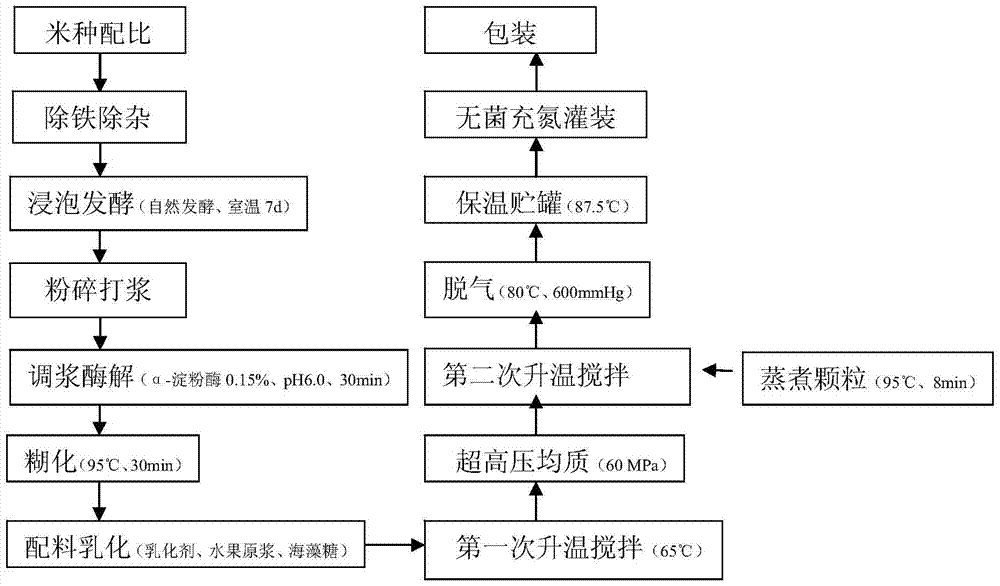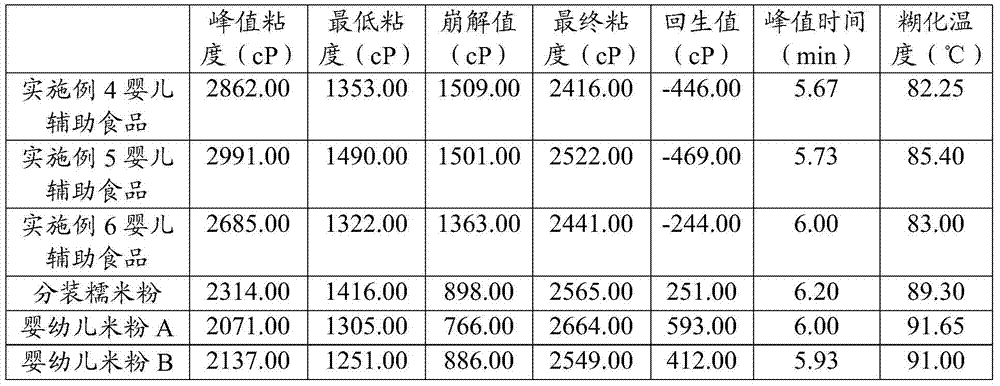A method for preparing supplementary food for infants and young children and the prepared supplementary food for infants and young children
A technology for supplementary food and infants, which is applied in the field of supplementary food for infants and the preparation of supplementary food for infants and young children, can solve the problems of high regeneration rate, high cost, low production efficiency, etc. Effect
- Summary
- Abstract
- Description
- Claims
- Application Information
AI Technical Summary
Problems solved by technology
Method used
Image
Examples
Embodiment 1
[0090]Embodiment 1, the impact of different raw materials on the regeneration value
[0091] Glutinous rice, japonica rice, indica rice, and rice with different ratios of glutinous rice, japonica rice, and indica rice were selected as raw materials, and the transformation of RVA under the preset temperature program was used to test the retrograde value. The results are shown in Table 1. The retrogradation rate is calculated according to the difference between the final viscosity and the peak viscosity. The larger the difference, the heavier the retrogradation.
[0092] Table 1 Test results of retrograde value of different raw materials
[0093]
[0094] Note: The disintegration value is the difference between the peak viscosity and the minimum viscosity; the retrograde value is the difference between the final viscosity and the peak viscosity.
[0095] The results in Table 1 show that the retrogradation value of raw materials mixed with japonica rice, early indica rice and...
Embodiment 2
[0096] Embodiment 2, the impact of immersion treatment on the regeneration value
[0097] With japonica rice, early indica rice and the mixed rice that the weight ratio of glutinous rice is 112:97:11 as raw material, be divided into two groups, one group is soaked in water for 7 days, and one group is soaked, detects two groups according to the detection method described in embodiment 1. The retrograde value of the group products, the results are shown in Table 2.
[0098] Table 2 Soaking treatment on the test results of the impact of retrogradation value
[0099]
[0100] The results in Table 2 show that the retrogradation value of the product after soaking treatment is relatively small, and the retrogradation rate is low.
Embodiment 3
[0101] Embodiment 3, the influence of emulsifying agent on retrograde value
[0102] The mixed rice with the weight ratio of japonica rice, early indica rice and glutinous rice as 112:97:11 is used as raw material, soaked in water and crushed to make rice milk, adjust the pH of the rice milk to 6.0-6.2, add α-amylase to enzymatically hydrolyze the rice Paste is gelatinized. The rice milk after gelatinization is divided into two groups, one group adds emulsifier glycerin fatty acid ester, another group does not add, detects the retrograde value of two groups of products according to the detection method described in embodiment 1, the result is as shown in table 3 Show.
[0103] Table 3 The test results of the impact of emulsifiers on the retrogradation value
[0104]
[0105] The results in Table 3 show that the retrograde value of the product added with emulsifier is significantly lower than that of the product without emulsifier added.
PUM
 Login to View More
Login to View More Abstract
Description
Claims
Application Information
 Login to View More
Login to View More - R&D
- Intellectual Property
- Life Sciences
- Materials
- Tech Scout
- Unparalleled Data Quality
- Higher Quality Content
- 60% Fewer Hallucinations
Browse by: Latest US Patents, China's latest patents, Technical Efficacy Thesaurus, Application Domain, Technology Topic, Popular Technical Reports.
© 2025 PatSnap. All rights reserved.Legal|Privacy policy|Modern Slavery Act Transparency Statement|Sitemap|About US| Contact US: help@patsnap.com



